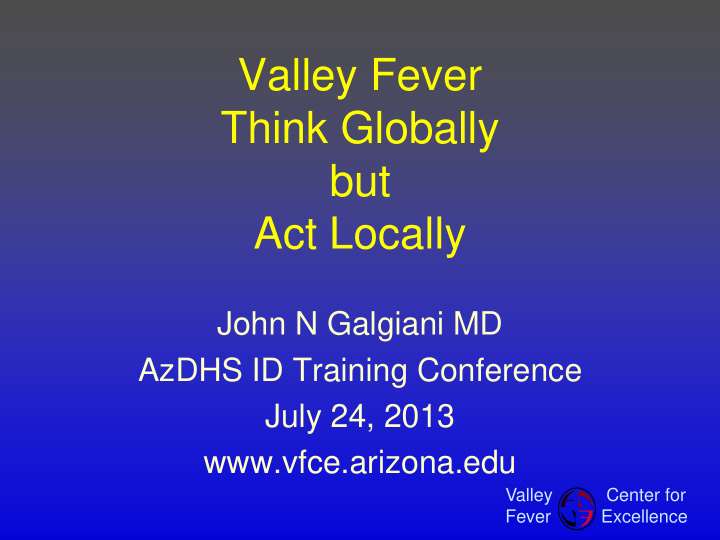



Valley Fever Think Globally but Act Locally John N Galgiani MD AzDHS ID Training Conference July 24, 2013 www.vfce.arizona.edu Valley Center for Fever Excellence
Valley Fever is a Western Hemisphere Disease
Valley Fever is a Western Hemisphere Disease
Valley Fever in the U.S. % Positive Skin Test 50-70 30-50 10-30 5-10 <5 Valley Center for www.vfce.arizona.edu Fever Excellence
Reported Valley Fever 20000 Arizona California 16000 12000 * 8000 4000 0 1990 95 2000 05 10 13 *Extrapolated from Jan-June of 2013
The Valley Fever Corridor: 2/3 of all US disease occur here Valley Center for www.vfce.arizona.edu Fever Excellence
Coccidioidomycosis Spectrum of Disease 100 Infections 60 No Symptoms 40 Symptoms 37 Recover Life-Long 2-4 Progress Immunity 3-4 Recur Disseminate Valley Center for Fever Excellence
“The case took months to diagnose. There’s no cure or vaccine. The D-Back’s centerfielder, who has been too weak for workouts, could spend the season recuperating.” -June 8, 2009 – Valley Center for www.vfce.arizona.edu Fever Excellence
Common “Mild” Valley Fever • Manifestations: – Cough, chest pain, fever, weight loss – Fatigue – Bone and joint pains (a.k.a. Desert Rheumatism) – Skin rashes (painful or intense itching) • Course of illness: – Weeks to months – 1 of 4 college students are sick for > 4 months – 4-fold more drop a semester for Valley Fever than for Mononucleosis Valley Center for Fever Excellence
In Southern Arizona A third of all pneumonia is Valley Fever Visitors to Arizona have the same risk soon after returning hom e 1,300/yr Az tourists with Valley Fever Valdivia et al, Emerg. Inf. Dis, 2006 Valley Center for Fever Excellence
Valley Fever in Arizona Findings from an AzDHS telephone survey 10% of reported cases in 2007 Impact on People Impact on Health Care – Illness lasted an – 25% needed more average of 6 months than 10 doctor visits – 40% hospitalized – 75% of workers off ($86 million in 2007) for over 1 month Patients who knew about Valley Fever were diagnosed sooner than those that didn’t Valley Center for Tsang et al., Emerg. Inf. Dis. 2010 Fever Excellence
Age Specific Rates of Reported Coccidioidomycosis in Arizona, 2004* 117/100,000 125.8 UA Campus Health 112.95 Cases per 100,000 81.76 57.08 38.7 23.64 8.86 0-9 10-19 20-29 30-39 40-49 50-59 60+ Age Groups in Years Valley Center for N Stern Emerg. Inf. Dis. 2010 Fever Excellence Infectious Disease Epidemiology
Valley Fever at UA Campus Health 1998-2006 Cases per 100,000 Patient group Incidence 95% CI Scholarship Athletes: 475 per yr 374 192-639 Non-Athletes: 35,525 per yr 90 79-103 Chi square, p < 0.00001 Valley Center for N Stern Emerg. Inf. Dis. 2010 Fever Excellence
Valley Fever at UA Campus Health 1998-2006 Percent Tested Patient group Tested 95% CI Athletes: 197 tests 4.6% 3.9%-5.4% Non-Athletes: 2,558 tests 0.8% .77%-.84% Chi square, p < 0.000001 Valley Center for N Stern Emerg. Inf. Dis. 2010 Fever Excellence
Organizing around Valley Fever in Arizona 1978: Galgiani arrives in Arizona 1995: Galgiani goes on a sabbatical 1996: Valley Fever Center for Excellence created. 2003: First Arizona Valley Fever Awareness week. Valley Center for Fever Excellence
11 th Annual Valley Fever Awareness Week November 9 th – 17 th 2013 Valley Center for Fever Excellence
Valley Fever Corridor Project • Started in 2008 • Goals – Increase understanding – Assist clinical research – Improve patient care (VFAAC) Valley Center for Fever Excellence
Valley Fever Alliance of Arizona Clinicians (VFAAC) Patient Needing Another Help Subspecialist Primary Care Subspecialist Clinician Valley Center for Fever Excellence
Valley Center for Fever Excellence
Valley Fever Center in Phoenix: June, 2012 St. Joseph’s Hospital The Partnership COM Phoenix Community VFCE Valley Center for Fever Excellence
Valley Fever Center in Phoenix First Year Summary Source of 420 Inquires Types of Problems • 61% Arizona (132 patients) – Maricopa (86%) 25% Valley Fever – Pima/ Pinal (9%) unlikely or inactive • 13% California 36% “Mild” Valley Fever • 3% each WA, TX pneumonia • 2% each UT, CO, NY 22% Complicated Valley • ≤ 1% each of 22 states Fever pneumonia • Also 15% Disseminated Valley Fever Canada, Australia, Italy, Spain, Argintina
Benefits from a VFC in Phoenix • Build on existing expertise in Arizona – Doctors across Arizona can be a part of VFC/P. – All clinicians share a common EMR (MobileMD) • Provide integrated management plans tailored to the specific needs of each patient. • Provide case management services to ensure that planned care is provided. Valley Center for Fever Excellence
Clinical Network and Research Vaccines New Drugs (Nikkomycin Z) Better Diagnostics Valley Fever Corridor Project; VFAAC; VFC-P Valley Center for Fever Excellence
Valley Fever Costs to Arizona Educate Arizona patients Nikkomycin Z development and doctors $40-$60 million (if things $100 thousand/year go well) Referral network and case Vaccine development management $40 million before $300 thousand/year clinical trials could begin Diagnostic test development Doing nothing $1.5 million $86 million per year just for hospital costs Valley Center for Fever Excellence
Thank-you Valley Fever Center for Excellence
Recommend
More recommend